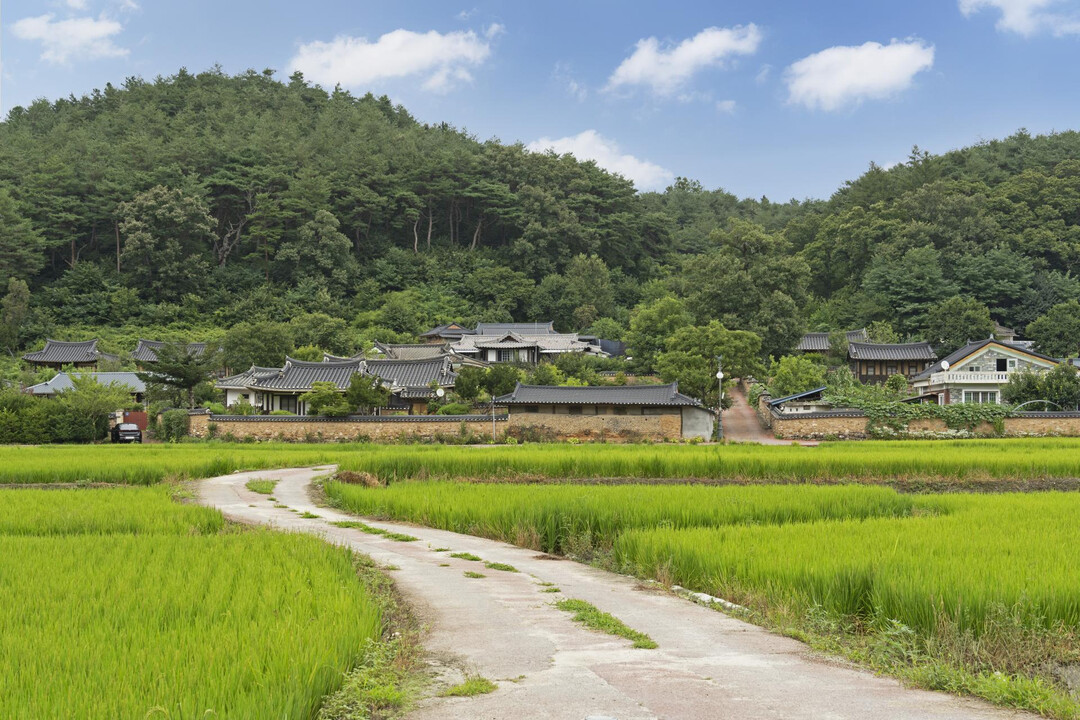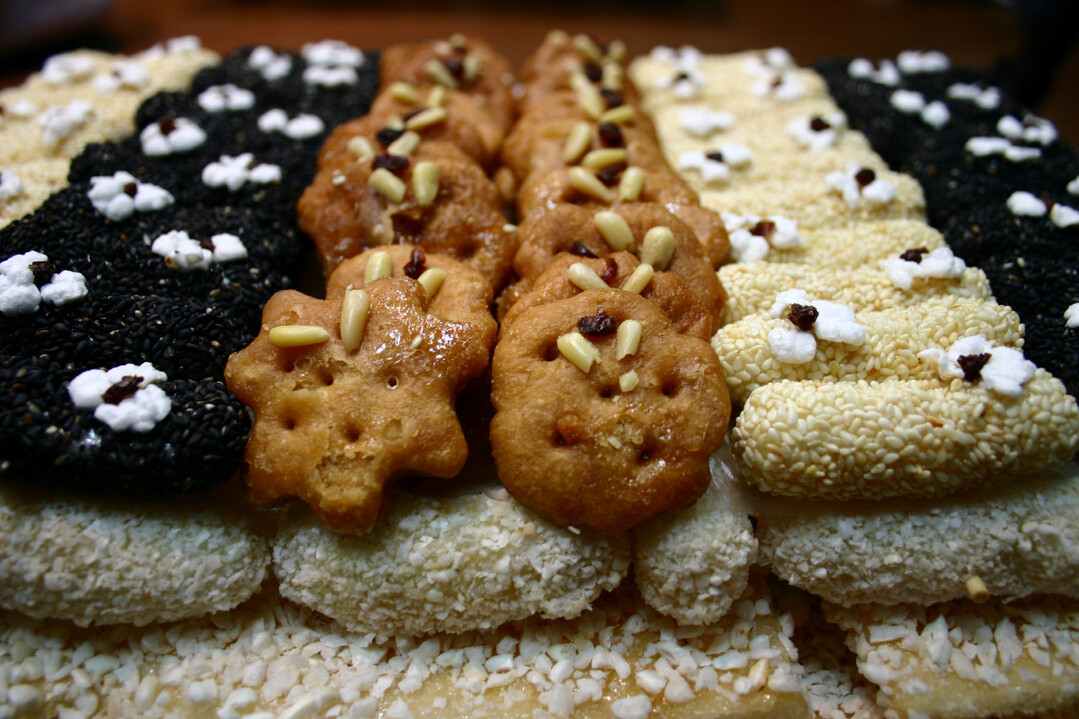
Nestled in Bonghwa, a region renowned for its prized matsutake mushrooms, Daksil Village unexpectedly greets visitors with a delicate, sweet aroma. This enticing fragrance, emanating from a small traditional tiled-roof house at the village entrance, belongs to the village's specialty: traditional Korean confections, or hangwa. Anticipation filled the air, reminiscent of Lunar New Year celebrations where grandmothers and mothers lovingly crafted these treats, as the path led towards the nostalgic flavors and picturesque scenery of Daksil Village.
Contrary to the expectation of being tucked away deep within a pristine mountain area, Daksil Village is conveniently located just a five-minute drive from Bonghwa town, appearing much like any other rural Korean village. However, those with an eye for feng shui will be immediately struck by its auspicious location. Alongside Gyeongju's Yangdong Village, Andong's Naeap Village, and Pungsan's Hahoe Village, Daksil is celebrated as one of the three most propitious sites in the Yeongnam region. Unlike Hahoe Village, shaped like a lotus flower floating on water, Daksil Village is known for its 'golden hen embracing an egg' (geumgye poranhyeong) formation, a name that hints at its exceptional character. It is no surprise that the descendants who have resided in this propitious land for over 500 years possess a remarkable heritage.
As anticipated, Daksil Village is a clan village of the Andong Kwon氏, the descendants of Kwon Beol (權<0x8D16>), a distinguished civil official from the mid-Joseon period. The village houses are predominantly traditional tiled-roof structures that bear the marks of time. While some have been renovated with modern elements or new tiles, the Jongga (head house) of Kwon Beol, situated on one side of the village, still exudes a classic charm, lending a unique atmosphere distinct from typical rural villages. At first glance, the deep-rooted history of the village and the traditional hangwa might not seem directly connected, especially given the common perception of hangwa as a treat enjoyed primarily during holidays or special occasions.
"As a family with a distinguished lineage, we must make hangwa properly," explains Sohn Sook, the 18th-generation Jongbu (wife of the head of the clan) of the Chungjeonggong派 branch of the Andong Kwon氏 and the general manager of the Daksil Village Women's Association, overseeing all aspects of hangwa production. Her words resonate with a deep sense of pride in her family's long-standing traditions and affection for them. "We cannot place just any food on the ancestral rites table. The same goes for hangwa. Our family has been renowned for its meticulous hangwa-making skills for generations. There isn't a person in this village who doesn't know how to make hangwa. Since we are all related and participate in ancestral rites together, it naturally became this way."
The 본격적인 fame of Daksil Village's hangwa began around 20 years ago. Due to its nature as a clan village, most residents are related. The custom of holding ancestral rites for up to four generations within a household meant that preparing ritual food was an almost daily occurrence in Daksil Village. Naturally, the women of the village gathered to prepare these dishes together, and through this process, Daksil Village hangwa maintained its high-quality taste and reputation over many years.
The exceptional hangwa-making skills of this noble family were already well-regarded. Recognizing the potential of Daksil Village hangwa, an official from the Bonghwa Agricultural Technology Center suggested external sales. Subsequently, the deep flavor of Daksil Village hangwa, passed down through generations, gained popularity nationwide through word of mouth, and Daksil Village eventually became widely known by its new name: "Hangwa Village."
"We make hangwa almost all year round, except for the summer," says one of the hangwa makers. "With the holidays approaching and more people avoiding factory-made snacks, the demand for handmade hangwa has increased. We still make everything carefully by hand, just as we always have. Please take a look in the other room."
The 'Daksil Traditional Hangwa' sign hangs on a cozy tiled-roof house, which serves as the workshop, officially named a 'Rural Women's Income Project Site.' Until a few years prior, hangwa was made in the village's old houses, but in 2004, with support from the county office, they moved to the current workshop. Despite being a workspace, it retains a warm and inviting atmosphere, much like any other traditional house.
Upon opening the door, a dozen grandmothers are seen sitting side-by-side, frying gwajul (oil-and-honey cookies). The savory aroma of the tteoksal (rice cake slices) sizzling in hot oil fills the air. With practiced movements, they place palm-sized tteoksal into the oil, pressing them gently with ladles on both sides. The tteoksal quickly expand and turn golden brown. The synchronized hands of the two women facing each other move with seamless precision. Soon, the tteoksal puff up to the size of large trays, eliciting admiration from onlookers.
The sight of the grandmothers gathered in the room, working together in a friendly atmosphere, evokes memories of visiting the extended family's home during childhood. The warm recollections of savory pancakes being fried in one corner and the sweet aroma of hangwa being made in another fill the heart with a poignant emotion.
The tteoksal being fried that day had been meticulously prepared the day before. Ground glutinous rice is steamed in a siru (earthenware steamer), then individually rolled out with a rolling pin into palm-sized pieces, and finally dried on a warm ondol (underfloor heating) floor. While a factory could easily handle this process with machinery, in Daksil Village, every step is carried out by hand with the care befitting a precious dish for the ancestral rites table.
The fried tteoksal are moved to the next room, where they are coated with honey or corn syrup and then evenly covered with puffed rice. Here too, modern automated equipment is nowhere to be found. From meticulously brushing on the honey or syrup to rolling the tteoksal to ensure every crevice is filled with puffed rice, every step requires human touch.
"If we thought it was hard, we couldn't do this work," says one grandmother. "We've been making it this way since we were young, so doing it any other way would actually be more inconvenient. We've made so much hangwa over the years that we can practically do it in our sleep."
The gwajul and gangjeong (sweet rice puffs) coated with puffed rice are then neatly cut into bite-sized pieces and finally placed in bamboo baskets. The colorful gangjeong, subtly dyed with gardenia seeds and safflower, are visually appealing. While one might assume this beautiful presentation is a recent trend, surprisingly, this exquisite gangjeong has been made in Daksil Village using the same traditional method for 500 years. And it's not just gangjeong. The delicate yakgwa (honey cookies), meticulously shaped using intricate molds, bloom into elaborate floral designs, pleasing the eye. It is reasonable to speculate that this beautiful tradition arose naturally because the hangwa offered at ancestral rites had to be not only delicious but also visually refined.

The hangwa, wrapped in elegant pink cloth, are immediately packed into delivery boxes and sent to customers across the country. Although freshness is not a significant concern in winter, sending freshly made, warm hangwa is a strict rule in Daksil Village. The names of customers densely written on the back of a calendar attest to the immense popularity of Daksil Village hangwa. As holidays approach, the Daksil Village Women's Association is constantly busy making *hangwa day and night.
"Even so, things are much easier now compared to the old days," recalls a grandmother. "When I first married into this family, it was really tough. Just following my mother-in-law to help with ancestral rites preparations would take up the whole day. And we couldn't just raise our voices or show our faces freely. Even bowing our heads as elders passed by was difficult. Being such a prestigious family, the rules were incredibly strict."
After a long day of strenuous hangwa making, the grandmothers lightly dust themselves off with a brief "Oh, my back!" and rise from their seats. They finally take a breather after sending off the delivery boxes.
A question arises: while the grandmothers are diligently making hangwa, where are all the men of the village?
"The men are probably at home or gathered somewhere," someone suggests. "Why don't you try the senior center?"
Indeed, in front of the village senior center, a neat row of men's shoes is visible. Peeking inside cautiously, the grandfathers are found enjoying rice wine and engaging in relaxed conversation. In this modern era of gender equality, their seemingly leisurely 모습 feels somewhat unexpected.
"We do our share of the hard work too," one grandfather clarifies. "We don't just sit around like the old folks used to. But we only know how to eat hangwa, not how to make it ourselves, so what can we do? In winter, we just gather here to pass the time, ha-ha."
However, the men of Daksil Village play a crucial role in preserving the village's history and traditions by regularly maintaining the historical sites and the Jongga scattered throughout the village. Recently, in particular, the beautiful pavilion Cheongamjeong located in the village has become a popular tourist destination after being featured as a filming location for the poster of the popular drama Painter of the Wind. The Daksil Village Jongga also welcomes visitors, leaving its main gate wide open for them to explore freely. While most visitors are respectful, occasionally some act inconsiderately and damage the cultural heritage, so the village men make it a routine to check on the Jongga frequently as they go about their day.
Cheongamjeong, situated on one side of the village, still boasts an exquisite charm, enough to inspire the two painters in the drama, even though the leaves have fallen due to the cold winter wind and the water in the surrounding waterway has dried up.
Right next to Cheongamjeong stands a sophisticated building that seems somewhat out of place in a rural village. This is the Chungjae Museum, which exhibits various materials related to Kwon Beol and the Andong Kwon氏 family. Well-organized to provide a comprehensive overview of Kwon Beol's life and achievements, as well as the long history of the Andong Kwon氏 clan, the museum offers a wealth of attractions that belie its location in a small rural village.
An elderly grandfather, who had been enjoying a warm time at the senior center, is seen giving a ride on the back of his bicycle to one of the grandmothers who was making hangwa, as they head home together in a heartwarming scene. In Daksil Village, which has preserved over 500 years of history and tradition, the sweet aroma of hangwa and the warm nostalgia of old times still vividly linger. If you long to feel the warmth of a forgotten hometown amidst a busy life, why not take a trip to Bonghwa's Daksil Village?
[Copyright (c) Global Economic Times. All Rights Reserved.]



























